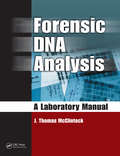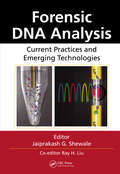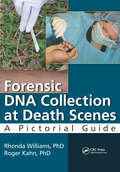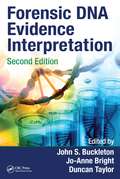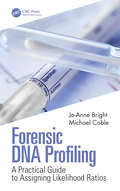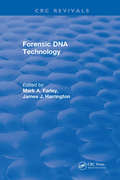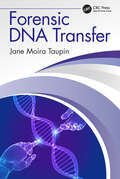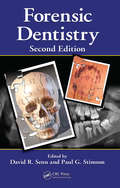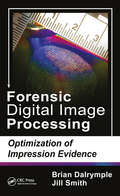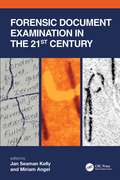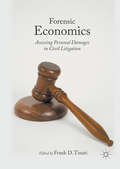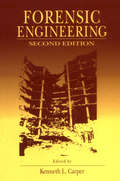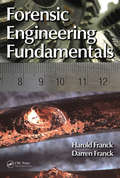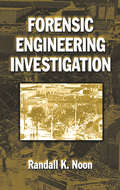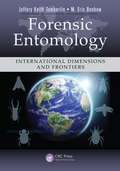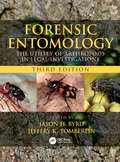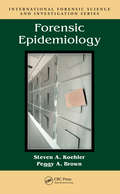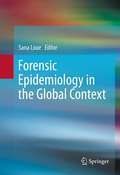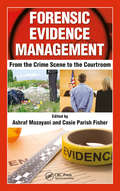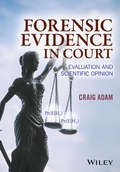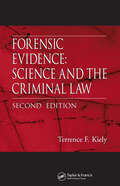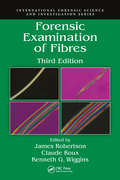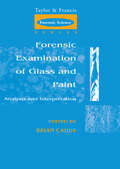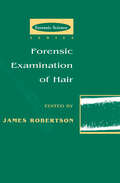- Table View
- List View
Forensic DNA Analysis: A Laboratory Manual
by J. Thomas McClintockIn its short but active history, the use of DNA typing has revolutionized criminal investigations. It is almost inconceivable to bring a case to trial without positive identification through what is now our most accurate means. Proficiency with the methodology, principles, and interpretation of DNA evidence is crucial for today‘s criminalist.
Forensic DNA Analysis: Current Practices and Emerging Technologies
by Jaiprakash G. ShewaleThe field of forensic DNA analysis has grown immensely in the past two decades and genotyping of biological samples is now routinely performed in human identification (HID) laboratories. Application areas include paternity testing, forensic casework, family lineage studies, identification of human remains, and DNA databasing. Forensic DNA Analysis:
Forensic DNA Collection at Death Scenes: A Pictorial Guide
by Rhonda Williams PhD F-ABC Roger Kahn PhD. F-ABCDNA evidence collected from death scenes is an essential tool for law enforcement, death investigators, and forensic pathologists providing insights into cause and manner of death as well as the identification of the responsible person or persons. Ineffective collection procedures raise the risk of evidence being altered or lost during transportati
Forensic DNA Evidence Interpretation
by John S. Buckleton Jo-Anne Bright Duncan TaylorNow in its second edition, Forensic DNA Evidence Interpretation is the most comprehensive resource for DNA casework available today. Written by leaders in the fields of biology and statistics, including a contribution from Peter Gill, the father of DNA analysis, the book emphasizes the interpretation of test results and provides the necessary formulae in an easily accessible manner. This latest edition is fully updated and includes current and emerging techniques in this fast-moving field. The book begins by reviewing all pertinent biology, and then provides information on every aspect of DNA analysis. This includes modern interpretation methods and contemporary population genetic models available for estimating DNA frequencies or likelihood ratios. Following a chapter on procedures for validating databases, the text presents overviews and performance assessments of both modern sampling uncertainty methods and current paternity testing techniques, including new guidelines on paternity testing in alignment with the International Society for Forensic Genetics. Later chapters discuss the latest methods for mixture analysis, LCN (ultra trace) analysis and non-autosomal (mito, X, and Y) DNA analysis. The text concludes with an overview of procedures for disaster victim identification and information on DNA intelligence databases. Highlights of the second edition include: New information about PCR processes, heterozygote balance and back and forward stuttering New information on the interpretation of low template DNA, drop models and continuous models Additional coverage of lineage marker subpopulation effects, mixtures and combinations with autosomal markers This authoritative book provides a link among the biological, forensic, and interpretative domains of the DNA profiling field. It continues to serve as an invaluable resource that allows forensic scientists, technicians, molecular biologists and attorneys to use forensic DNA evidence to its greatest potential.
Forensic DNA Evidence Interpretation
by John S. Buckleton, Jo-Anne Bright and Duncan TaylorNow in its second edition, Forensic DNA Evidence Interpretation is the most comprehensive resource for DNA casework available today. Written by leaders in the fields of biology and statistics, including a contribution from Peter Gill, the father of DNA analysis, the book emphasizes the interpretation of test results and provides the necessary formulae in an easily accessible manner. This latest edition is fully updated and includes current and emerging techniques in this fast-moving field. The book begins by reviewing all pertinent biology, and then provides information on every aspect of DNA analysis. This includes modern interpretation methods and contemporary population genetic models available for estimating DNA frequencies or likelihood ratios. Following a chapter on procedures for validating databases, the text presents overviews and performance assessments of both modern sampling uncertainty methods and current paternity testing techniques, including new guidelines on paternity testing in alignment with the International Society for Forensic Genetics. Later chapters discuss the latest methods for mixture analysis, LCN (ultra trace) analysis and non-autosomal (mito, X, and Y) DNA analysis. The text concludes with an overview of procedures for disaster victim identification and information on DNA intelligence databases.Highlights of the second edition include: New information about PCR processes, heterozygote balance and back and forward stuttering New information on the interpretation of low template DNA, drop models and continuous models Additional coverage of lineage marker subpopulation effects, mixtures and combinations with autosomal markers This authoritative book provides a link among the biological, forensic, and interpretative domains of the DNA profiling field. It continues to serve as an invaluable resource that allows forensic scientists, technicians, molecular biologists and attorneys to use forensic DNA evidence to its greatest potential.
Forensic DNA Profiling: A Practical Guide to Assigning Likelihood Ratios
by Jo-Anne Bright Michael CobleDNA testing and its forensic analysis are recognized as the “gold standard” in forensic identification science methods. However, there is a great need for a hands-on step-by-step guide to teach the forensic DNA community how to interpret DNA mixtures, how to assign a likelihood ratio, and how to use the subsequent likelihood ratio when reporting interpretation conclusions. Forensic DNA Profiling: A Practical Guide to Assigning Likelihood Ratios will provide a roadmap for labs all over the world and the next generation of analysts who need this foundational understanding. The techniques used in forensic DNA analysis are based upon the accepted principles of molecular biology. The interpretation of a good-quality DNA profile generated from a crime scene stain from a single-source donor provides an unambiguous result when using the most modern forensic DNA methods. Unfortunately, many crime scene profiles are not single source. They are described as mixed since they contain DNA from two or more individuals. Interpretation of DNA mixtures represents one of the greatest challenges to the forensic DNA analyst. As such, the book introduces terms used to describe DNA profiles and profile interpretation. Chapters explain DNA extraction methods, the polymerase chain reaction (PCR), capillary electrophoresis (CE), likelihood ratios (LRs) and their interpretation, and population genetic models—including Mendelian inheritance and Hardy-Weinberg equilibrium. It is important that analysts understand how LRs are generated in a probabilistic framework, ideally with an appreciation of both semicontinuous and fully continuous probabilistic approaches. KEY FEATURES:• The first book to focus entirely on DNA mixtures and the complexities involved with interpreting the results • Takes a hands-on approach offering theory with worked examples and exercises to be easily understood and implementable by laboratory personnel • New methods, heretofore unpublished previously, provide a means to innovate deconvoluting a mixed DNA profile, assign an LR, and appropriately report the weight of evidence • Includes a chapter on assigning LRs for close relatives (i.e., “It’s not me, it was my brother”), and discusses strategies for the validation of probabilistic genotyping software Forensic DNA Profiling fills the void for labs unfamiliar with LRs, and moving to probabilistic solutions, and for labs already familiar with LRs, but wishing to understand how they are calculated in more detail. The book will be a welcome read for lab professionals and technicians, students, and legal professionals seeking to understand and apply the techniques covered.
Forensic DNA Technology
by Mark A. FarleyForensic DNA Technology examines the legal and scientific issues relating to the implementation of DNA print technology in both the crime laboratory and the courtroom. Chapters have been written by many of the country's leading experts and trace the underlying theory and historical development of this technology, as well as the methodology utilized in the Restriction Fragment Length Polymorphism (RFLP) and Polymerase Chain Reaction (PCR) techniques. The effect of environmental contaminants on the evidence and the statistical analysis of population genetics data as it relates to the potential of this technology for individualizing the donor of the questioned sample are also addressed. Other topics include the proposed guidelines for using this technology in the crime laboratory, the perspective of the prosecution and the defense, the legal standards for determining the admissibility and weight of such evidence at trial. Finally, the issues of validation and the standards for interpretation of autoradiograms are brought into focus in a detailed study of actual case work. Forensic scientists, prosecuting attorneys, defense attorneys, libraries, and all scientists working with DNA technology should consider this a "must have" book.
Forensic DNA Transfer
by Jane Moira TaupinForensic DNA Transfer provides a guide to the recognition and current understanding of DNA transfer in forensic criminal investigations. Increased improvements in technology mean that it is now routinely possible to obtain DNA profiles from non-visible deposits. How or when the DNA in question was deposited may be an issue in the context of the case, especially if the donor of the DNA is not in dispute. A DNA profile alone cannot reveal when or how that DNA was deposited at a crime scene, nor can it reveal the body matter from which it originated. Issues of transfer associated with activities may be debated – which the traditional discrimination purpose of DNA profiling cannot address. DNA may be everywhere and anywhere – in homes, at workplaces, during transport, and on personal items including clothing. DNA from a person may be on an object they have never contacted or in a room they have never entered. Concepts discussed in the book include non-self DNA on hands through day-to-day activities, the prevalence of background DNA in the environment and perhaps on the exhibit, the persistence of any DNA transferred, and that a DNA result will depend on these variables as well as recovery techniques. Since DNA may be transferred to an exhibit: (a) during the commission of a crime, (b) before the crime, and/or (c) after the crime through handling, examination, and testing, this book covers various transfer pathways and sources of DNA. Inadvertent issues of transfer of DNA resulting in wrongful convictions and the misleading of investigations are discussed, with an emphasis on contamination mitigation. Forensic DNA Transfer examines the additional complexity resulting from non-visible deposits of DNA that impact on sampling and testing regimes. The changing understanding of the composition of purported 'touch DNA' deposits from the skin, including extracellular DNA transported via body secretions is described. Further, the newer focus on interpreting DNA evidence – using activity level propositions and the rationale and associated issues – is also discussed.
Forensic Dentistry
by David R. Senn Paul G. StimsonThe identification of unknown individuals and the estimation of age, race, and gender are among the chief functions of forensic dentistry. Other important applications include the investigation and analysis of bitemarks and oral injuries in abuse cases and evaluating, reporting, and testifying in civil litigation cases. Twelve years after the benchmark first edition of this book explored these topics, the long-awaited Forensic Dentistry, Second Edition offers a comprehensive update and revision of the material.Offering insight from many new contributors on the cutting edge of forensic science and odontology, this new edition expands the book’s scope to include a broader historical and theoretical analysis, a thorough assessment of the past decade’s developments, and a far-reaching projection of future trends.New topics in the second edition include: Forensic dental radiography Age estimation Jurisprudence and legal issues History of forensic dentistry Landmark cases, including September 11th and Hurricane Katrina In order for forensic odontology to continue to progress as a specialty of forensic science, there must be a consistent stream of new ideas and original and applied research. Heavily illustrated and enhanced with a 16-page color insert with additional photos, this volume captures the critical issues that confront today’s forensic dentist, explores the field’s limitations, and provides a window on the future of this crucial sector within the forensic identification science arena.
Forensic Digital Image Processing: Optimization of Impression Evidence
by Brian Dalrymple Jill SmithThe digital revolution over the past several decades has advanced every facet of evidence detection, photography, optimization, and interpretation. Forensic scientists and practitioners have benefited tremendously from the move from film to digital. With proper procedures in place, digital images and casework capabilities have increased tremendously in both complexity and range due to a vast array of tools to enhance evidence and photography. Forensic Digital Image Processing: Optimization of Impression Evidence provides the forensic investigator with the tools and understanding to extract, optimize, and interpret the maximum evidence possible from crime scenes to increase identifications. The book begins by examining the emergence of forensic digital image processing, and the gradual improvement and acceptance of the science over the past four decades. Coverage includes looking at the issues of image integrity and authentication including forensic image optimization and the manipulation of images. Chapters explore techniques exploiting color theory, modes, and channels to optimize signal-to-noise ratio in images. One of the greatest assets of digital image technology is the ability to combine multiple images of the same subject to create a final, blended image: one that displays the desired evidence and is especially useful for fingerprint or footwear impression. Later chapters demonstrate image subtraction, focus stacking, and high dynamic range, utilizing images in optimum focus and with substrate interference diminished or removed entirely. The authors look at fast Fourier transform as an optimal tool for noise removal, addressing basic theory and diagnosis of the noise signatures. The book discusses the history of digital imaging techniques and their treatment within the court system. Forensic Digital Image Processing: Optimization of Impression Evidence serves as an invaluable resource and tool for practicing professionals–as well as those new to the field—to look at best practices, the latest technology, and advances in utilizing the increasing array of tools of the trade.
Forensic Document Examination in the 21st Century
by Jan Seaman Kelly Miriam AngelForensic Document Examination in the 21st Century covers the latest technology and techniques providing a complete resource on contemporary issues and methods in forensic document examination. Forensic document examiners provide their findings as expert testimony in court. Due to rapid changes in technology, including digital documents, printing and photocopying capabilities, and more, there is a great need for this up-to-date reference. The examination of documents can include comparison of handwriting or hand-printing; detection of alterations or photocopier and computer manipulation; restoration or decipherment of erased and obliterated writing; visualization of latent impressions; the identification of printing processes; and differentiation of inks. Computer-generated documents are prevalent, and electronically-captured signatures are becoming more widespread, meaning the knowledge of advances in technology and adoption of new validated techniques and methods of document examination are crucial to the reliability of forensic opinions. Forensic Document Examination in the 21st Century includes the latest research on the subject and with contributions from leading experts on their various areas of expertise. The book will be a welcome addition to the literature and support the foundational basis for methods and procedures for use it expert testimony in court, serving as a resource for forensic document examiners, trainees, and those in the criminal and legal communities who use the services of expert document examiners and witnesses
Forensic Economics: Assessing Personal Damages in Civil Litigation
by Frank D. TinariThis edited collection addresses the major issues encountered in the calculation of economic damages to individuals in civil litigation. In federal and state courts in the United States, as well as in other nations, when one party sues another, the suing party is required not only to prove that the harm was, indeed, caused by the other party, but also to claim and demonstrate that a specified dollar value represents just compensation for the harm. Forensic economists are often called upon to evaluate, measure, and opine on the degree of economic loss that is alleged to have occurred. Aimed at both practitioners and theorists, the original articles and essays in the edited collection are written by nationally recognized and widely published forensic experts. Its strength is in showcasing theories, methods, and measurements as they differ in a variety of cases, and in its review of the forensic economics literature developed over the past thirty years. Readers will find informative discussions of topics such as establishing earnings capacity for both adults and infants, worklife probability, personal consumption deductions, taxation as treated in federal and state courts, valuing fringe benefits, discounting theory and practice, the effects of the Affordable Care Act, the valuation of personal services, wrongful discharge, hedonics, effective communication by the expert witness, and ethical issues. The volume also covers surveys of the views of practicing forensic economists, the connection between law and forensic economics, alternatives to litigation in the form of VCF-like schedules, and key differences among nations in measuring economic damages.
Forensic Engineering
by Kenneth L. CarperThis edition of Forensic Engineering updates the original work with new case studies and investigative techniques. Contributors to the book are the foremost authorities in each area of specialization. These specialty areas include fire investigation, industrial accidents, product liability, traffic accidents, civil engineering and transportation di
Forensic Engineering Fundamentals
by Harold Franck Darren FranckForensic engineers often specialize in a particular area such as structures, fires, or accident reconstruction. However, the nature of the work often requires broad knowledge in the interrelated areas of physics, chemistry, biomechanics, and engineering. Covering cases as varied as assessment of workplace accidents to the investigation of Halliburt
Forensic Engineering Investigation
by Randall K. NoonForensic Engineering Investigation is a compendium of the investigative methodologies used by engineers and scientific investigators to evaluate some of the more common types of failures and catastrophic events. In essence, the book provides analyses and methods for determining how an entity was damaged and when that damage may have legal consequen
Forensic Entomology: International Dimensions and Frontiers (Contemporary Topics in Entomology)
by M. Eric Benbow Jeffery Keith TomberlinThe use of forensic entomology has become established as a global science. Recent efforts in the field bridge multiple disciplines including, but not limited to, microbiology, chemistry, genetics, and systematics as well as ecology and evolution. The first book of its kind, Forensic Entomology: International Dimensions and Frontiers provides an inc
Forensic Entomology: The Utility of Arthropods in Legal Investigations, Third Edition
by Jason H. Byrd; Jeffery K. TomberlinForensic Entomology: The Utility of Arthropods in Legal Investigations, Third Edition continues in the tradition of the two best-selling prior editions and maintains its status as the single-most comprehensive book on Forensic Entomology currently available. It includes current, in-the-field best practices contributed by top professionals in the field who have advanced it through research and fieldwork over the last several decades. The use of entomology in crime scene and forensic investigations has never been more prevalent or useful given the work that can be done with entomological evidence. The book recounts briefly the many documented historical applications of forensic entomology over several thousand years. Chapters examine the biological foundations of insect biology and scientific underpinnings of forensic entomology, the principles that govern utilizing insects in legal and criminal investigations. The field today is diverse, both in topics studied, researched and practiced, as is the field of professionals that has expanded throughout the world to become a vital forensic sub-discipline. Forensic Entomology, Third Edition celebrates this diversity by including several new chapters by premier experts in the field that covers such emerging topics as wildlife forensic entomology, microbiomes, urban forensic entomology, and larval insect identification, many of which are covered in depth for the first time. The book will be an invaluable reference for investigators, legal professionals, researchers, practicing and aspiring forensic entomologists, and for the many students enrolled in forensic science and entomology university programs.
Forensic Epidemiology (International Forensic Science and Investigation)
by Steven A. Koehler Peggy A. BrownAfter 9/11, forensic epidemiology emerged as a leading investigative tool, partnering public health officers with law enforcement like never before. Based on the authors first-hand experience, Forensic Epidemiology brings to light the vast amounts of information collected by medical examiners that will be useful in advancing death investigation te
Forensic Epidemiology in the Global Context
by Sana LoueAs globalization causes profound changes in business, industry, and trade,it can also have significant effects on populations, environments, and individuals.These effects may be harmful, resulting in injury or illness, prompting the critical question: How best to correct wrongs caused to individuals, communities, and/or the environment of one country by the actions of individuals or corporations of another? Possible answers lie in an emerging discipline. Forensic Epidemiology in the Global Context opens meaningful windows onto the processes of forensic epidemiology, the roles of the epidemiologist in civil disputes, and the potential contribution of the field to legal and justice efforts worldwide. Case examples from the U.K., Nigeria, Ecuador, Romania, and Australia illustrate commonly used methodologies and the challenges involved in their use in U.S. and international courts of law. A chapter on expert testimony takes readers through qualification and admissibility issues, report requirements, and working with attorneys. Included in the coverage: Forensic epidemiology in the international legal arena.The epidemiologist as an expert in litigation.Epidemiological evidence in tort law: dispatches from the U.K.Liability for occupational exposure: the role of epidemiology.Forensic epidemiology and environmental justice.Forensic epidemiology, pathology, ethnics, and human rights.By emphasizing both the scientific and legal components of the equation, Forensic Epidemiology in the Global Context gives researchers and graduate students in epidemiology a unique and timely guide to the present and future of an increasingly salient field.
Forensic Evidence Management: From the Crime Scene to the Courtroom
by Ashraf Mozayani Casie Parish-Fisher"Evidence management has become a crucial component for the law enforcement community. I truly believe this book is essential in assisting criminal investigators and a valuable resource for managing evidence."—Jeremiah Sullivan, Chairman, Board of Directors, Texas Division of the International Association for Identification; Senior Crime Scene Specialist (Retired). Austin Police Department As technology and technical applications continue to advance in the forensic sciences, the undertakings at crime scenes have become even more critical. Crime scene investigators must ensure that evidence is properly collected, document, packaged, and stored in a manner that maximizes the ability of laboratories to derive meaning and results from the evidence provided them. Forensic Evidence Management: From the Crime Scene to the Courtroom provides best practices policies for forensic science entities and their employees to maintain chain of custody and evidence integrity throughout the course of evidence collection, storage, preservation, and processing. The focus of the book will be to address the issues related with evidence handling and analysis inside the forensic laboratory, in particular, and to offer best practices and guidelines from leading forensic experts in the field. Forms of evidence covered include biological, chemical, trace, firearm, toolmark, fingerprint, and a host of others types recovered at crime scenes. The book concludes with a chapter on ethics, bias, and ethical practices in evidence handling in the field and laboratory analysis. Test Bank and PowerPointTM slides are available for download from the Taylor & Francis ancillary Web site for qualifying course adopters.
Forensic Evidence in Court: Evaluation and Scientific Opinion
by Craig D. AdamThe interpretation and evaluation of scientific evidence and its presentation in a court of law is central both to the role of the forensic scientist as an expert witness and to the interests of justice. This book aims to provide a thorough and detailed discussion of the principles and practice of evidence interpretation and evaluation by using real cases by way of illustration. The presentation is appropriate for students of forensic science or related disciplines at advanced undergraduate and master's level or for practitioners engaged in continuing professional development activity.The book is structured in three sections. The first sets the scene by describing and debating the issues around the admissibility and reliability of scientific evidence presented to the court. In the second section, the principles underpinning interpretation and evaluation are explained, including discussion of those formal statistical methods founded on Bayesian inference. The following chapters present perspectives on the evaluation and presentation of evidence in the context of a single type or class of scientific evidence, from DNA to the analysis of documents. For each, the science underpinning the analysis and interpretation of the forensic materials is explained, followed by the presentation of cases which illustrate the variety of approaches that have been taken in providing expert scientific opinion.
Forensic Evidence: Science and the Criminal Law, Second Edition
by Terrence F. KielyFocusing on issues raised at Interpol‘s 14th Forensic Science Symposium, this volume offers a complete overview and analysis of the scientific and legal aspects of each of the forensic disciplines. It updates cases and discusses recent applications of Frye/Daubert, the admissibility of eyewitness identification, the explosion of cases and statutes addressing post-conviction DNA, the rise in attention to cold cases, and other challenges. This is the book that those in the forensic sciences need to have on hand to successfully prepare for what may await them in the courtroom.
Forensic Examination of Fibres (International Forensic Science and Investigation)
by James Robertson Claude Roux Kenneth G. WigginsIn order for forensic fibre examiners to fully utilize fibre and textile evidence during their analysis, they require not only specialised forensic knowledge but also in-depth knowledge of fibres, yarns and fabrics themselves. Production, both the chemical and physical structure, and the properties of these materials is required in order to determine the value of fibre evidence. This includes knowing production figures, fashion changes, sudden arrivals of new materials, dye variability, and numerous other factors that may have a bearing on the information obtained. Fully updated with the latest advances, Forensic Examination of Fibres, Third Edition continues in the tradition of the First (1992) and Second Editions (1999) as the premier text on the subject of forensic fibre analysis. The international team of contributing authors detail the recovery of the evidence—through the different stages of laboratory examination—to the evaluation of the meaning of findings. The coverage has been considerably expanded, and all material, has been revised and wholly updated. Topics covered include examining damaged textiles, infrared microspectroscopy and thin layer chomatography, and colour analyses. This edition also highlights the critical role of quality assurance in ensuring the reliability of the technical observations and results, and, in doing so, looks at the implications of supervisory managers and labs in the accurate and responsible analysis of such evidence. Features include: Outlining evidentiary process from collecting and preserving the evidence at the crime scene through the laboratory analysis of fibres Detailing the latest developments and emerging technologies including Kevlar and other such advances in fibre technology Coverage of a broad array of fibres both, natural (cellulose, protein, and mineral) and man-made fibres including synthetic, inorganic and regenerated Forensic Examination of Fibres, Third Edition is a much-needed update to the classic book, serving as an indispensable reference to crime scene technicians, laboratory forensic scientists and microscopists, students in police, forensic, and justice science programs.
Forensic Examination of Glass and Paint: Analysis and Interpretation
by Brian CaddyThis volume represents an approach to the analysis of glass and paint as they occur as trace evidence in forensic cases. Each chapter is written by an expert in their particular area. The book is divided into two sections: one referring to paint and one referring to glass. Each section covers an introduction to the composition of these materials an
Forensic Examination of Hair (International Forensic Science and Investigation)
by James RobertsonThe examination of human hairs in the forensic science setting is a highly specialist forensic discipline. To date the topic has not been covered in a single volume in which all aspects of hair examination are brought together. In this volume an international group of authors have dealt with all aspects of the examination of human hair. The volume opens with the basic foundation accidence covering the physiology, growth and structure of hair. Forensic specific aspects of hair structure are then dealt with and a protocol for examination is presented. The remaining chapters deal with non microscopy approaches to hair examination covering historical and contemporary knowledge. These chapters include biochemical approaches to hair examination,
